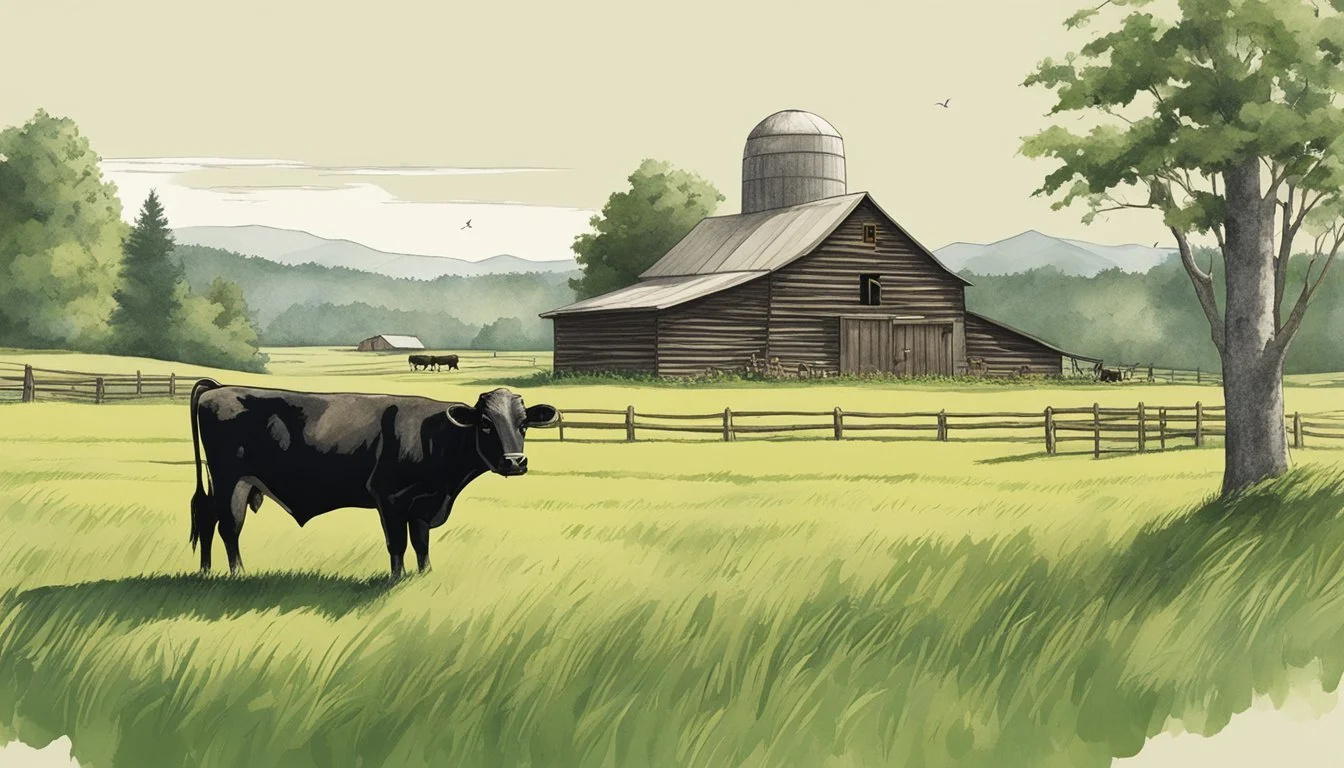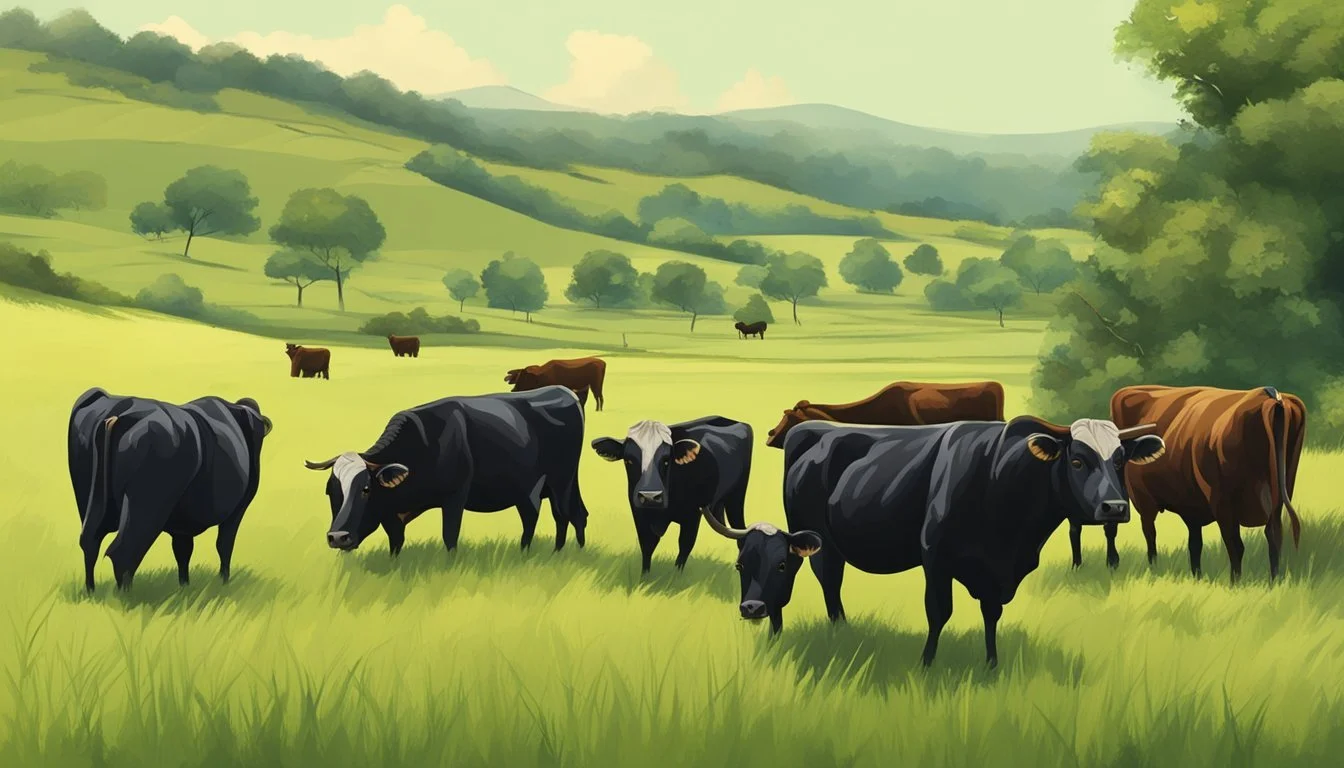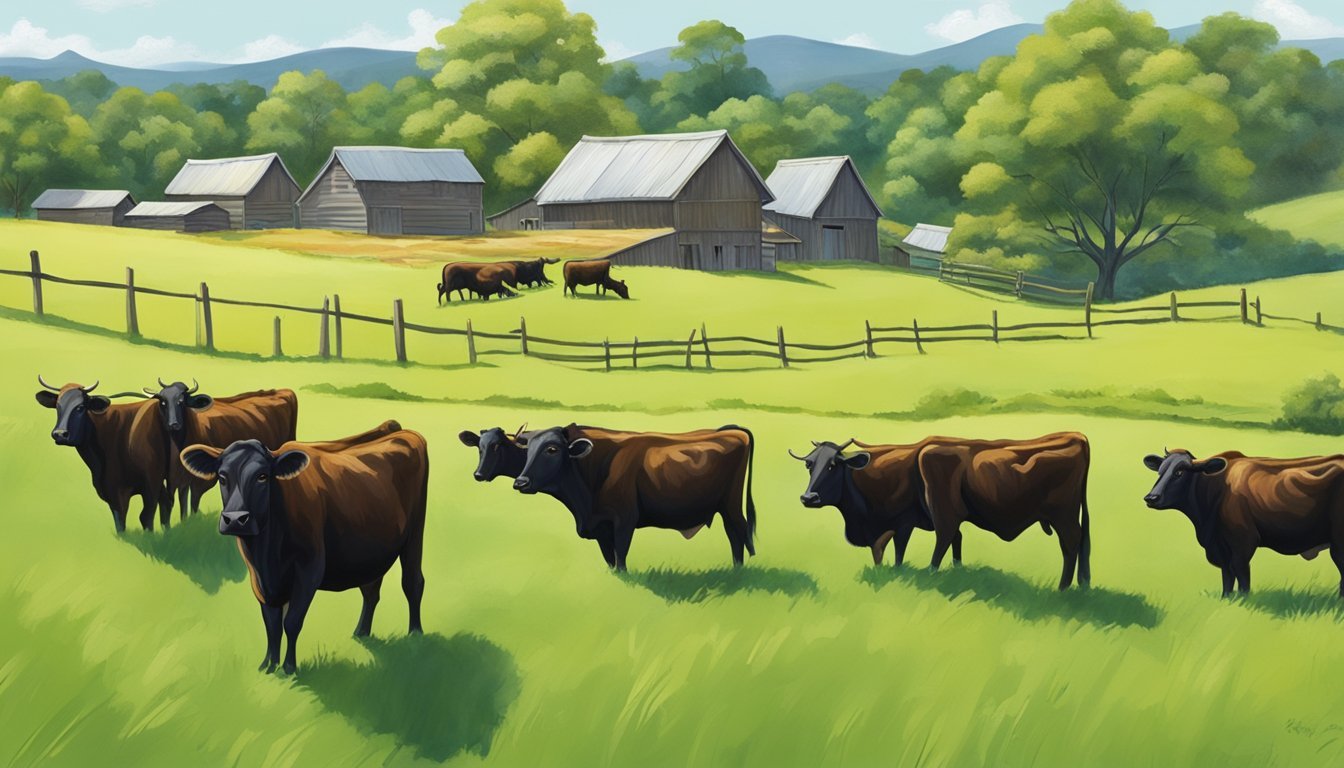Dexter Cattle and the Preservation of Rural Traditions
Embracing Agrarian Heritage
Dexter cattle, a breed with a rich heritage rooted in southwestern Ireland, embody a living legacy of rural traditions. These small, hardy animals were traditionally kept by small landholders in the Kerry region, where they were prized for their versatility and adaptability. As one of the smallest European cattle breeds, Dexters are recognized for their ability to thrive in varied climates and conditions, making them an ideal choice for small-scale farming practices that are integral to rural life.
The preservation of Dexter cattle is not merely about maintaining a breed; it's about upholding the rural traditions and cultures that have developed around them. Organizations such as the American Dexter Cattle Association have been dedicated to this cause since 1957, ensuring that the lineage of purebred Dexter cattle continues unadulterated. Through careful record-keeping and a commitment to the original characteristics of the breed, these organizations support the ongoing viability of Dexter cattle, which in turn helps sustain the rural traditions associated with them.
By preserving the Dexter breed, communities are also preserving a way of life that has been integral to their history and identity. The Dexter cattle serve as a symbol of self-sufficiency and resilience, qualities that are core to the spirit of rural traditions. Their tri-purpose nature—providing dairy, beef, and draft power—reflects the resourcefulness required to prosper in rural environments. This conservation effort connects current and future generations to their agricultural heritage, ensuring that the legacy of both Dexter cattle and the traditions they support is carried forward.
Historical Significance of Dexter Cattle
Dexter cattle, a heritage breed with roots dating back to the 18th century Ireland, hold considerable historical significance. Their preservation reflects a commitment to rural traditions and genetic diversity.
Origins and Early History
Dexter Cattle originated in the southern part of Ireland, more specifically in County Kerry. The breed is named after a Mr. Dexter, who managed estates for Lord Hawarden. Initially, Dexters were considered a type of Kerry cattle, known for their versatility and smaller stature.
The Royal Dublin Society was instrumental in the development and promotion of Dexter cattle in Ireland. The first recorded appearance of the breed was in 1776, and by the late 1800s, they were recognized as a distinct breed. In 1892, the English Kerry and Dexter Cattle Society initiated the first herd book, formalizing their status as a separate breed and promoting their conservation.
Dexter Cattle in America
Dexter cattle were first imported to America early in the 20th century. John H. Logsdon reportedly brought them to his farm in Illinois. Following this introduction, interest in Dexters grew, leading to the formation of the American Kerry and Dexter Club in 1911, which later evolved into the American Dexter Cattle Association (ADCA).
The ADCA was officially named in 1957, solidifying its exclusive focus on Dexters. By this time, the association had begun to maintain pedigree records, a crucial step in breed preservation. Despite a decline in numbers by the mid-1970s, due to renewed efforts, Dexters did not become extinct in the United States.
Breed Conservation and Associations
The survival and conservation of Dexter cattle have heavily relied on dedicated organizations. The Dexter Cattle Society, previously known as the English Kerry and Dexter Cattle Society, shifted its focus exclusively to Dexters in 1924. It played a key role in breed promotion and the maintenance of lineage records.
In the US, breed preservation was fostered by the formation of associations such as the ADCA, which maintains purebred pedigrees to this day. Dexters are now classified as a rare breed, with conservation efforts being vital to their continued existence. Associations provide resources and support to both new and experienced Dexter owners, ensuring that this historic breed remains an integral part of rural traditions.
Physical Characteristics of Dexter Cattle
Dexter cattle are a distinctive breed known for their smaller stature and hardy nature, characterized by a broad body and varying colors. They present a unique genetic profile that contributes to their appearance, health, and longevity.
Size and Appearance
Dexter cattle are the smallest European cattle breed, standing at 36 to 44 inches tall and weighing up to 750 pounds. They typically have a well-rounded hindquarters and can exhibit either short or long legs, a trait directly tied to the presence of the chondrodysplasia gene. Their coat is thick and comes in mainly three colors: solid black, red, and dun. Variations such as spotting or brindling are less common, and excessive white markings, particularly those not on the underline, are considered undesirable.
Genetics and Breed Variations
The breed exhibits a rich genetic tapestry, where the most notable gene is responsible for chondrodysplasia, often referred to as the 'dwarfism gene'. This gene causes the short-legged variety within the breed. Dexter cattle can also be either polled (naturally hornless) or horned, and the polled gene is dominant. Historically, the breed was predominantly horned, but modern breeding has seen an increase in the naturally polled variety.
Health and Longevity
Dexter cattle are known for their hardy nature and longevity, thriving in various environments. However, they can carry two lethal genes: one for chondrodysplasia and another for pulmonary hypoplasia with anasarca (PHA), which is typically fatal. Responsible breeding practices have helped manage these concerns. Regular veterinary check-ups are essential to maintain their health, with a particular focus on monitoring for any genetic conditions. Despite these genetic issues, Dexter cattle do not generally require excessive veterinary care due to their inherent robustness.
Raising Dexter Cattle
The practice of raising Dexter cattle is a sustainable choice for small acreage farming, providing efficiency in breeding, grazing, and land use, while upholding rural traditions with this compact breed.
Breeding Practices
Dexter cattle are known for their high fertility rates and relative ease of calving, which makes them a favorable option for breeding purposes. A distinct characteristic of the breed is its dual-purpose nature, offering both quality beef and milk production. Heifers can be bred at a younger age compared to larger breeds, often around 18 months, and they typically exhibit strong maternal instincts. This leads to a productive breeding cycle with minimal calving difficulties, making it a manageably efficient process even for less experienced farmers.
Grazing and Feed Efficiency
These small-sized bovines are celebrated for their feed efficiency. Dexter cattle are able to thrive on less forage as they convert feed to body weight more effectively than many larger breeds. Their grazing habits are gentle on the land, making them well-suited for limited acreage and varied climatic conditions. They are also adaptable to mountainous regions, where their compact size allows them to navigate the terrain and utilize forage inaccessible to larger cattle.
Housing and Land Requirements
Dexter cattle require less space than conventional cattle breeds. Their compact size results in lower land requirements, as they generally need only about a half to one acre per head. Their adaptability to various climates and conditions allows for a range of housing options. In mountainous or rough terrains, simple shelters may suffice as long as they provide protection from severe weather. This aspect makes them particularly favorable for small-scale farms and contributes to preserving rural traditions by enabling sustainable cattle farming on limited acreage.
Dexter Cattle in Agriculture
Dexter cattle serve a significant role in agriculture, particularly respected for their dual-purpose capabilities in meat and milk production. They have a storied presence in small-scale farming and carry substantial potential for future agricultural use.
Dual-Purpose Utilization
Dexter cattle are a dual-purpose breed, desirable for both their milk and meat. Their milk is noted for its high butterfat content, making it particularly valued for cheese making and other dairy products. In terms of meat, Dexter cattle provide lean and well-marbled beef cuts, which are often sought after by both consumers and artisan butchers for their quality and flavor.
Dexter Cattle for Small-Scale Farming
These compact cattle fit well in small-scale farming operations. Dexters require less pasture and feed than larger breeds, which makes them cost-effective and well-suited to the smaller farm's resources. They are also known to have a gentle temperament, doubling as pets and making them a good fit for families and hobby farmers looking to maintain rural traditions.
Temperament: Gentle and friendly
Feed Efficiency: High, suitable for smaller pastures
Size: Small, manageable for limited space
Prospects for Dexter Cattle
The promotion of Dexter cattle by associations has helped the population recover from rarity, casting a promising light on their future in agriculture. These cattle are not only appreciated for their dual uses but also for their ability to adapt to various climatic conditions. As distribution grows, so does their role in both preserving agricultural tradition and contributing to sustainable farming practices.
Associations: Dexter cattle are supported by dedicated organizations like the American Dexter Cattle Association.
Climate Adaptability: Capable of thriving in varied environments.
Sustainability: Their small size and efficiency support eco-friendly farming methods.
Dexter cattle continue to be promoted as a beneficial asset to the agricultural community, embodying efficiency and versatility for the modern small-scale farmer.
Cultural Impact and Rural Traditions
Preserving rural traditions is a multifaceted challenge that includes maintaining the cultural impact of livestock breeds such as Dexter Cattle. This small-sized breed not only supports a way of life but is making its way in modern sustainable farming due to its unique characteristics.
Rural Livelihoods and Dexter Cattle
Rural communities have long relied on Dexter Cattle as an integral part of their agricultural practices. Recognized for their solid build and even temperament, these animals are highly valued for their multipurpose role on small farms. Dexter Cattle are docile in nature, which makes them excellent for handling, even for those with less experience. They support rural livelihoods not only as a source of high-quality meat but also through their:
Milk production: Dexter Cows provide milk that is high in solids, particularly suitable for cheese and butter making.
High fertility rate: They have a consistent breeding cycle, contributing to herd sustainability.
This breed embodies the quintessence of rural traditions, where raising livestock is not just an economic activity, but a cultural practice that reinforces the identity and cohesion of the community.
Dexter Cattle in Modern Farming
Today's farming methods continue to evolve, yet Dexter Cattle remain relevant due to their adaptability to various environmental conditions and smaller scale operations. Their small breed size offers advantages in modern farming:
Resource Efficiency: They require less pasture and are efficient foragers, making them a cost-effective choice for sustainable farming practices.
Suitability for Organic Farms: Their resilience and low-impact lifestyle fit well with organic farming ethics.
The presence of Dexter Cattle in modern farming echoes a bridge between traditional ways and contemporary demands, demonstrating the breed's resilience and the enduring significance of these animals in rural culture. They function not only as a source of livelihood but also as stewards of an agricultural heritage that continues to shape the rural landscape.
Economic Considerations
In exploring the economic impact of Dexter cattle, two significant factors emerge: their influence on market demand and value, and the sustainability and environmental benefits they offer to rural traditions and modern farming practices.
Market Demand and Value
Dexter cattle are revered for their dual-purpose qualities, providing both quality lean meat and milk, which in turn affects their market demand and value. These small-sized cattle are adaptable to various climates and farming systems, which has led to a steady interest among small-scale farmers and those involved in niche marketing.
Lean Meat: Dexter cattle are prized for their lean meat, with less marbling compared to larger beef breeds. This characteristic caters to a market segment that prefers a healthier red meat option.
Market Presence: As consumers increasingly seek out locally-sourced and sustainable food options, Dexter cattle have garnered attention for their lower environmental impact and the preservation of rural traditions.
Sustainability and Environmental Benefits
Dexter cattle contribute positively to sustainability and environmental stewardship, an economic consideration that aligns with the growing eco-conscious consumer base.
Size and Efficiency: Their compact body types require less pasture and feed, translating to reduced costs for farmers and a smaller environmental footprint.
Conservation Grazing: Dexter cattle are often used in conservation grazing, helping to maintain and improve biodiversity, which has indirect economic benefits by supporting ecosystems services that agriculture and communities depend on.
The economic role of Dexter cattle extends beyond direct profitability, influencing both market trends and the sustainability of agricultural practices.
Conclusion
The significance of Dexter cattle extends beyond their compact stature and versatility in farming operations. They represent a key element in the preservation and conservation of rural traditions, blending heritage with the pragmatic needs of contemporary agriculture. Their unique genetic profile not only contributes to biodiversity but also presents an opportunity for sustainable farming practices.
Preservation Efforts: Dexter cattle enthusiasts and organizations like the American Dexter Cattle Association are pivotal in maintaining the breed's lineage through careful breeding and promoting its benefits. These efforts ensure that future generations can continue to engage with these cattle as part of rural life and agricultural heritage.
Education and Community: Sharing knowledge about Dexter cattle encourages informed decisions about livestock that align with conservation objectives. This includes recognizing the breed’s adaptability and smaller environmental footprint compared to larger cattle.
Sustainable Future: Dexter cattle hold promise for small-scale farmers seeking to adapt to changing economic landscapes and environmental concerns. Their efficient land use, combined with lower feed requirements, positions them as a sensible choice for maintaining rural livelihoods in a responsible manner.
Cultural Significance: The cattle's role in cultural practices and as a symbol of status and self-esteem in rural communities underscores the importance of ensuring their continuity. Supporting Dexter cattle is a means to safeguard a cultural asset, synonymous with resilience and rural identity.
To ensure the breed's preservation, a concerted effort involving research, community involvement, and sustainable practices will be pivotal. Through these collaborative actions, Dexter cattle will continue to be an integral facet of agricultural heritage and a living link to rural traditions.








